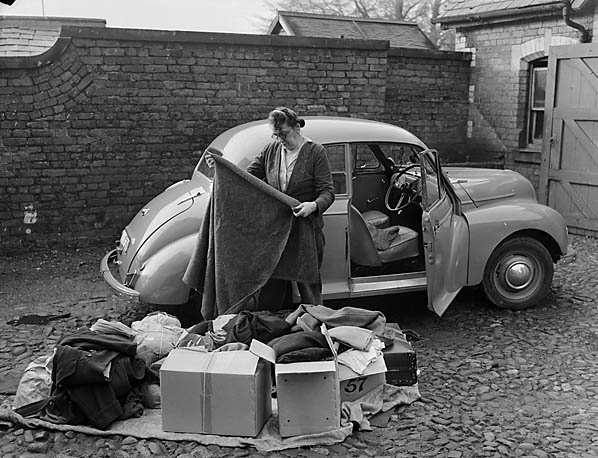Population Displacement as a result of Conflict in the 21st Century
One of the consistent messages that Europeana receives from the the research community is the need for high quality data, and of a sufficient depth to cater for different research questions within different research themes
As part of the Europeana Cloud project, a team from Work Package 1 are exploring different topics and assessing the current research requirements and available tools and resources for that topic. This will help Europeana assess the feasibility of aggregating data in this area.
Population movement, or ‘migration’ is a common occurrence and has been throughout history. Indeed, nations have been founded upon it. The causes of population movement can be mostly economic in peacetime, as we currently see at both a national level, and in the EU, as well as further afield.
| Image: "Clothing collected for Hungarian relief effort", taken from Casgliad Geoff Charles Collection, National Library of Wales |
However, other causes of population movement can be more sinister, due to religious persecution (or indeed the pursuit of religious freedom, as was seen in the movement of Pilgrims to the Americas), enforced banishment through criminal punishment, relocating after a natural disaster, or simply fleeing for one’s life in times of conflict.
This research into the content of Europeana, and potential opportunities for further resources looks at population displacement due to conflict in Europe in the 20th Century. The 20th Century was a century of war as never seen before, with industrial weaponry and ideological conflicts across the world. Within Europe, this led to huge displacement of people, either fleeing as refugees or forced migration. This continued right up to the last decade of the century with the Balkans’ War that divided former Yugoslavia.
This topic, while given more time and resources it could potentially cover every European conflict within this period of time, focuses on 3 semi-related conflicts and the effects they had on populations in 3 key locations across Europe - The Greek-Turkish conflict of the 1920s; the Hungarian Revolution of 1956 and the refugees that fled the country; and the Balkans’ (former Yugoslavia) War of the 1990s.
Research projects within this field could focus on the patterns of migration, the causes of migration, the ease of migration, how the migrants were received in their destinations, did this depend on the sympathies of the destination countries with their plight? The involvement of the surrounding countries and how they may or may not have been able to help? Could UK assistance have helped refugees in the Hungarian Revolution, for example? How have attitudes changed towards migrants from Eastern Europe within the EU since the Cold War ended?
Through looking into this topic, it is clear that any content relating to this area of research would benefit scholars in the fields of History, Peace/Conflict studies, Politics, Sociology, and European Studies to name but a few.
So far our research has focussed mainly on the Hungarian Revolution of 1956, and has begun looking into potential for studies into the Balkan’s War of the 1990s. Europeana already has a rich source of materials around the Hungarian Revolution, in particular the Radio Free Europe transcripts that include testimonies and stories from refugees that made it across the borders and told their stories.
The wealth of newspapers available through Europeana can also reveal what and how various countries were reporting on the Revolution and how events unfolded. These too can also reveal the attitudes towards the brief Revolution, and offer some manner of justification for actions taken (or not taken).
Challenges that lie ahead, however, include not only trying to find digital resources and ensuring that their licensing agreements allow for reuse, but in the case of the more recent conflicts, those that are still within living memory, finding material could prove more tricky. Documents, particularly relating to the 1990s conflict in the Balkan states may be still under a 30 year embargo (or however long each government allows for sensitive documents). Similarly, those who lived through the conflicts may be reluctant to talk about them, possibly due to trauma, or even shame at the part they played. The culture of secrecy and reporting inside the Iron Curtain where many of these countries lay could still be felt today, 20+ years after the wall fell.
It is nonetheless a topic worth pursuing, as historians will be keen to reveal new stories from the latter half of the 20th century. Tools used so far to try to gather data, and create some manner of storyboard to the items in collections have included Pinterest, Story Map Journal and Culture Collage. Each has potential for showing these stories, but each needs to be more powerful to include the kind of information that can be more easily interrogated.
The work continues……
If you are working in similar research and would like to shape how Europeana might develop its content to assist you, please get in touch! We would love to have a chat with you about what would help you most. Please email Vicky Garnett at garnetv@tcd.ie, Norman Rodger at norman.rodger@ed.ac.uk, or Martin Schaller at martin.schaller@onb.ac.at



